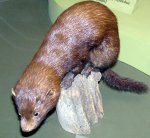 The American Minks (Mustela vison) are considered as part of the Weasel Family, they are scattered over North America, but do not expect to find one at the tundra areas or Southwest US...unless of course, if somebody took it for a pet and brought it there. I am speaking about the American Mink, and akin to many other weasels, they have a similar physique. Usually, one weighs 2.07 kg, and the males are usually bigger than the female side. The color of the American Minks' hair range from brown to something very close to black, but the underside has a lighter shade. An American Mink's soft, thick fur gives warmth and protection when in they are in aquatic places. They are nocturnal, active the whole year long, and are outstanding swimmers. In the treacherous world of animals, they are fair game for coyotes, foxes, bobcats and even owls (yes, owls, believe it or not).
The American Minks (Mustela vison) are considered as part of the Weasel Family, they are scattered over North America, but do not expect to find one at the tundra areas or Southwest US...unless of course, if somebody took it for a pet and brought it there. I am speaking about the American Mink, and akin to many other weasels, they have a similar physique. Usually, one weighs 2.07 kg, and the males are usually bigger than the female side. The color of the American Minks' hair range from brown to something very close to black, but the underside has a lighter shade. An American Mink's soft, thick fur gives warmth and protection when in they are in aquatic places. They are nocturnal, active the whole year long, and are outstanding swimmers. In the treacherous world of animals, they are fair game for coyotes, foxes, bobcats and even owls (yes, owls, believe it or not). Creatures usually at the shorelines serve as the American Mink's basic food requirements, such as muskrats, shrews, various fish, frogs, salamanders, earthworms and insects. They ordinarily live in burrow (roots of trees) or shelters created by beavers. The males journey more than the distaff side, and they utilize many of the said places. According to records, at the UK mainland, these Minks survive on rats and rabbits.
Interesting fact: It has been known that they have the capability to kill snakes, but... they do not seem to eat them.
Keywords: tail , paw , black , white
The American mink is listed as Least Concern (LR/lc), lowest risk. Does not qualify for a more at risk category. Widespread and abundant taxa are included in this category, on the IUCN Red List of Threatened Species
Namings for the American mink
A young / baby of a American mink is called a 'cub or kit'. The females are called 'sow' and males 'boar'.